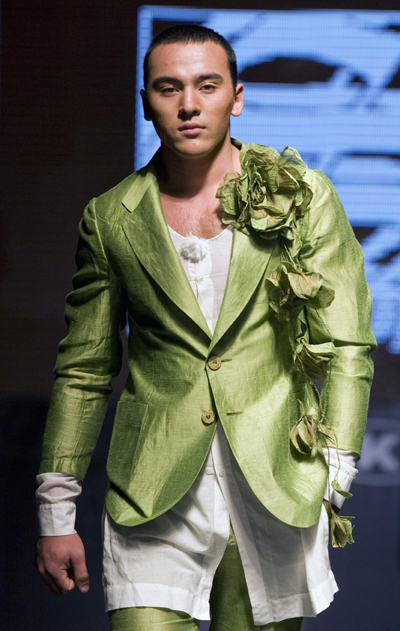A university freshman has become the first person to die from A(H1N1) influenza in Beijing, bringing the mainland toll to four.
The male student, whose name has not been released, died on Tuesday amid an H1N1 outbreak at Beihang University, the nation's top aeronautic and astronautic institution.
In a brief statement issued last night, the health bureau said: "The patient was sent to Daxing District Hospital on Monday and died in the hospital on Tuesday."
The death brings to four the number of victims killed by H1N1 on the mainland. The other three people lived in western China, with the most recent in the Xinjiang Uygur autonomous region.
The health bureau said the man was among 3,000 freshmen participating in compulsory military drills and that a group of students began showing symptoms of influenza last Thursday.
A total of 71 students recorded a fevers and 28 tested positive for H1N1 virus. The students were in a stable condition last night.
News of the man's death came as almost 4,000 visitors converged on the university for a national scientific competition yesterday.
A staff member, who was unaware of the death, told METRO on condition of anonymity that the school may try to play down the H1N1 outbreak because of the competition.
"It is a tough decision for the school leaders. They have been busy having meetings for three consecutive days," said another school staff member with the executive office last night.
Meanwhile, authorities urged the university to tighten its disease control and quarantine measures.
Imran Sadiq, an overseas researcher from Pakistan at Beihang, told METRO yesterday that he received an e-mail from school authorities about the latest flu precaution measures on Tuesday evening.
"The school told us once again to report ourselves once we have coughing or any other flu symptoms," said the 39-year-old PhD candidate.
METRO observed nearly all students having their temperatures recorded before entering dormitories at the campus yesterday.
At men's dormitory No 16, supervisors and volunteers pointed electronic thermometers to the forehead of each student returning from lunch.
It came as authorities warned that the daily influenza infection rate could hit 12,000 by January. And it will not be long before most of the flu cases are almost entirely H1N1.
"There is a long battle ahead as the city counters this year's flu infection," said Fang Laiying, head of the Beijing municipal health bureau, at an emergency meeting held yesterday.
"Near the New Year, the number of people who catch the flu - whether or not they go to hospital - could reach 12,000 people per day.
"More than half of them could be infected with H1N1 influenza, and we have not reached peak time yet."
More than 6,000 Beijing residents are catching the flu every day, hospital records show. This is five times more than the same period last year, and half of these people are infected with H1N1 influenza. The remainder is infected with seasonal influenza.
Pediatric departments in 103 hospitals began 24-hour operations at midnight Wednesday after a spike in the number of young patients infected with influenza.
Though the number of young patients registered at the city's two major hospitals has begun to drop, doctors said the total number of children suffering from the flu is expected to increase with the colder weather.
The city government has started offering H1N1 flu vaccines, and vaccinations for primary and middle school students as well as public servants in Beijing will be complete by Nov 20.
The rest of Beijing residents, on conditions of their willingness, will receive their vaccine injections by Dec 20, the healthy authority said.
A university freshman has become the first person to die from A(H1N1) influenza in Beijing, bringing the mainland toll to four.
The male student, whose name has not been released, died on Tuesday amid an H1N1 outbreak at Beihang University, the nation's top aeronautic and astronautic institution.
In a brief statement issued last night, the health bureau said: "The patient was sent to Daxing District Hospital on Monday and died in the hospital on Tuesday."
The death brings to four the number of victims killed by H1N1 on the mainland. The other three people lived in western China, with the most recent in the Xinjiang Uygur autonomous region.
The health bureau said the man was among 3,000 freshmen participating in compulsory military drills and that a group of students began showing symptoms of influenza last Thursday.
A total of 71 students recorded a fevers and 28 tested positive for H1N1 virus. The students were in a stable condition last night.
News of the man's death came as almost 4,000 visitors converged on the university for a national scientific competition yesterday.
A staff member, who was unaware of the death, told METRO on condition of anonymity that the school may try to play down the H1N1 outbreak because of the competition.
"It is a tough decision for the school leaders. They have been busy having meetings for three consecutive days," said another school staff member with the executive office last night.
Meanwhile, authorities urged the university to tighten its disease control and quarantine measures.
Imran Sadiq, an overseas researcher from Pakistan at Beihang, told METRO yesterday that he received an e-mail from school authorities about the latest flu precaution measures on Tuesday evening.
"The school told us once again to report ourselves once we have coughing or any other flu symptoms," said the 39-year-old PhD candidate.

METRO observed nearly all students having their temperatures recorded before entering dormitories at the campus yesterday.
At men's dormitory No 16, supervisors and volunteers pointed electronic thermometers to the forehead of each student returning from lunch.
It came as authorities warned that the daily influenza infection rate could hit 12,000 by January. And it will not be long before most of the flu cases are almost entirely H1N1.
"There is a long battle ahead as the city counters this year's flu infection," said Fang Laiying, head of the Beijing municipal health bureau, at an emergency meeting held yesterday.
"Near the New Year, the number of people who catch the flu - whether or not they go to hospital - could reach 12,000 people per day.
"More than half of them could be infected with H1N1 influenza, and we have not reached peak time yet."
More than 6,000 Beijing residents are catching the flu every day, hospital records show. This is five times more than the same period last year, and half of these people are infected with H1N1 influenza. The remainder is infected with seasonal influenza.
Pediatric departments in 103 hospitals began 24-hour operations at midnight Wednesday after a spike in the number of young patients infected with influenza.
Though the number of young patients registered at the city's two major hospitals has begun to drop, doctors said the total number of children suffering from the flu is expected to increase with the colder weather.
The city government has started offering H1N1 flu vaccines, and vaccinations for primary and middle school students as well as public servants in Beijing will be complete by Nov 20.
The rest of Beijing residents, on conditions of their willingness, will receive their vaccine injections by Dec 20, the healthy authority said.
A university freshman has become the first person to die from A(H1N1) influenza in Beijing, bringing the mainland toll to four.
The male student, whose name has not been released, died on Tuesday amid an H1N1 outbreak at Beihang University, the nation's top aeronautic and astronautic institution.
In a brief statement issued last night, the health bureau said: "The patient was sent to Daxing District Hospital on Monday and died in the hospital on Tuesday."
The death brings to four the number of victims killed by H1N1 on the mainland. The other three people lived in western China, with the most recent in the Xinjiang Uygur autonomous region.
The health bureau said the man was among 3,000 freshmen participating in compulsory military drills and that a group of students began showing symptoms of influenza last Thursday.
A total of 71 students recorded a fevers and 28 tested positive for H1N1 virus. The students were in a stable condition last night.
News of the man's death came as almost 4,000 visitors converged on the university for a national scientific competition yesterday.
A staff member, who was unaware of the death, told METRO on condition of anonymity that the school may try to play down the H1N1 outbreak because of the competition.
"It is a tough decision for the school leaders. They have been busy having meetings for three consecutive days," said another school staff member with the executive office last night.
Meanwhile, authorities urged the university to tighten its disease control and quarantine measures.
Imran Sadiq, an overseas researcher from Pakistan at Beihang, told METRO yesterday that he received an e-mail from school authorities about the latest flu precaution measures on Tuesday evening.
"The school told us once again to report ourselves once we have coughing or any other flu symptoms," said the 39-year-old PhD candidate.

METRO observed nearly all students having their temperatures recorded before entering dormitories at the campus yesterday.
At men's dormitory No 16, supervisors and volunteers pointed electronic thermometers to the forehead of each student returning from lunch.
It came as authorities warned that the daily influenza infection rate could hit 12,000 by January. And it will not be long before most of the flu cases are almost entirely H1N1.
"There is a long battle ahead as the city counters this year's flu infection," said Fang Laiying, head of the Beijing municipal health bureau, at an emergency meeting held yesterday.
"Near the New Year, the number of people who catch the flu - whether or not they go to hospital - could reach 12,000 people per day.
"More than half of them could be infected with H1N1 influenza, and we have not reached peak time yet."
More than 6,000 Beijing residents are catching the flu every day, hospital records show. This is five times more than the same period last year, and half of these people are infected with H1N1 influenza. The remainder is infected with seasonal influenza.
Pediatric departments in 103 hospitals began 24-hour operations at midnight Wednesday after a spike in the number of young patients infected with influenza.
Though the number of young patients registered at the city's two major hospitals has begun to drop, doctors said the total number of children suffering from the flu is expected to increase with the colder weather.
The city government has started offering H1N1 flu vaccines, and vaccinations for primary and middle school students as well as public servants in Beijing will be complete by Nov 20.
The rest of Beijing residents, on conditions of their willingness, will receive their vaccine injections by Dec 20, the healthy authority said.
 A student has his temperature taken before being allowed access to his dormitory.
A student has his temperature taken before being allowed access to his dormitory.
taken from : China Daily






















































